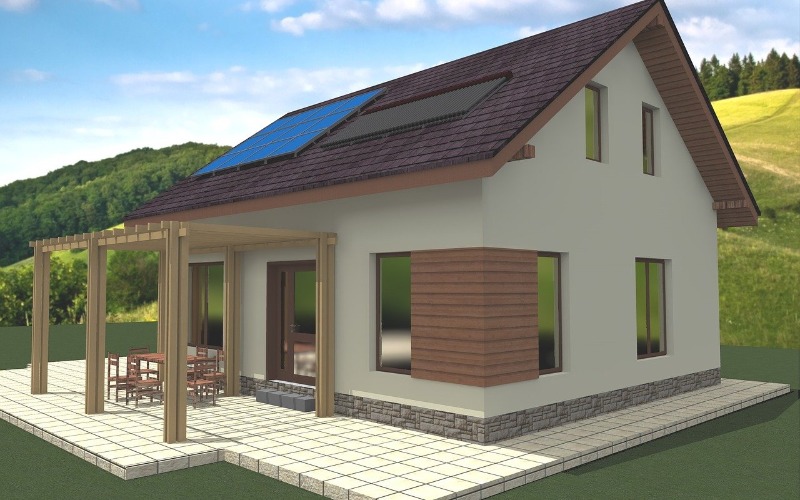The building and construction sector is the biggest culprit in the climate crisis. The construction industry uses over 3 billion tons of raw materials, including sand, wood, and iron ore, accounting for 42% of global carbon emissions. With the UN predicting that the homelessness or slum population is expected to rise to 2 billion by 2030, the need for low-cost, alternative housing is only increasing.
Using 3D printers to build homes has emerged as a pioneering solution to these crises. There’s a compelling sustainability and social case for building 3D-printed homes: average construction costs are a quarter of the price of traditionally built homes, and their carbon footprint is around 30% lower.
Using plastic water bottles may initially sound far-fetched as an answer to sustainability and social challenges in housing. However, recent innovations show promising results in the industry’s race to net zero. Here’s how to use recycled materials to print 3D homes and build a more sustainable future.
What Materials Are Needed and How Does It Work?
Recycled polymer materials, such as plastic water bottles, are an affordable and accessible material to use in the construction process. For example, accessory dwelling units (ADUs) can use up to around 100,000 plastic water bottles.
There are different methodologies for utilizing these recycled materials depending on the size of the printing project. Initially, materials are shredded into flakes and ground to prevent extruder clogging. Polymers can be converted into a pelletized form before extrusion in large formative additive manufacturing processes.
A blueprint is created and converted to an STL file, which runs through a slicer program to create contours for each print layer (for large 3D printers, slicers are typically specific to the machine). These are subsequently converted into G-code and sent to the printer. Depending on factors such as cost, accessibility, units required, and customization, there are various locations where printing can take place. Mobile printers can print directly on-site, or teams may use micro-factories to print modules (walls, roofs, floors, and foundations) off-site.
The pre-dried printing material is heated and squeezed out through the 3D printer’s nozzle, layer by layer. Typically, plastics are dried to remove moisture bubbles before getting fed into the printer so layers fuse more seamlessly during printing.
Environmental Advantages of 3D-Printed Houses Using Recycled Materials
It’s important to take a step back and contextualize the construction industry’s role in global warming. The statistics paint a harrowing picture of current sustainability risks, as well as the benefits of adopting 3D printing as a solution to these challenges.
The built environment contributes to a whopping 42% of global carbon emissions and embodied carbon emissions from materials (cement, iron, steel, aluminum) are an additional 15% annually. More than 1 million plastic water bottles are purchased every minute worldwide—and over 90% of these are not recycled. Creating an incentive to reuse plastic water bottles properly is an innovative solution to tackling the global consequences of single-use plastic waste.
And, with the UN citing the increasing urgency for reducing embodied carbon at the construction stage, it’s crucial that buildings are climate resilient from their very foundations. 3D-printing homes with plastic waste tackles the goliath challenge of Scope 3 emissions head-on by integrating recycled materials into the very beginning of the construction process.
Overcoming Challenges in Adopting This Technology on a Large Scale
One of the biggest hurdles is the expertise gap in utilizing the technology needed. The equipment and tools are still arguably in their early days of development. Training engineers and teams to utilize 3D printing technology to build homes will take time and money to fill the skills gap.
What’s more, high turnover rates in the manufacturing industry, such as 37% in the US alone, according to Awardco, also exacerbate this expertise gap. Platforms that leverage data-actioning processes and transmit instructions can provide real-time on-the-job training, powering efficiency to onboard new workers and upskill construction and manufacturing teams.
Another challenge is the additional construction materials and labor required. Current 3D printing technology largely only encompasses the modules (flooring, roofing, and walls). Developing applicable technologies to build beyond these elements will require further research and development in the industry.
Finally, navigating complex government regulations on structural strength, acceptable materials, zoning laws, and inspections and permitting requirements may impede 3D printing projects.
Building a More Sustainable and Affordable Housing Future
The built environment is at the crux of solving the climate crisis. As part of the journey to reaching sustainability goals and curb carbon emissions, there needs to be a drastic change to how homes are built.
Additionally, the convergence of economic and environmental crises is displacing people, causing a tragic surge in homelessness. Building affordable and dignified housing is an increasing urgency around the world. 3D printing homes using recycled materials is a promising innovation for solving these global issues and building a more sustainable future.











